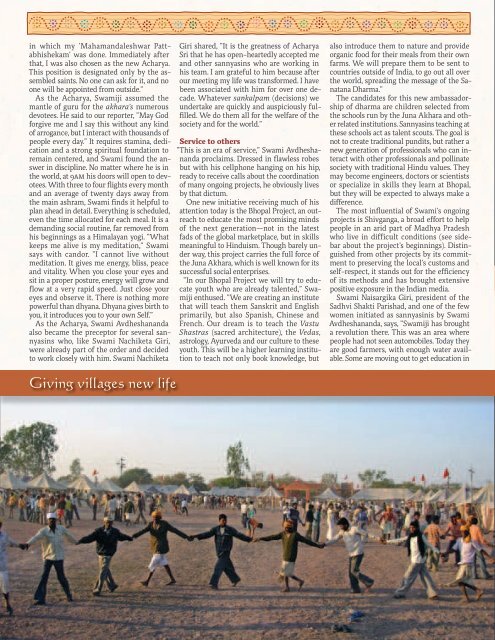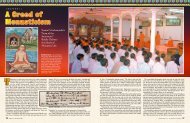Hinduism Today January 2009 - Cover, Index, Front Articles
Hinduism Today January 2009 - Cover, Index, Front Articles
Hinduism Today January 2009 - Cover, Index, Front Articles
You also want an ePaper? Increase the reach of your titles
YUMPU automatically turns print PDFs into web optimized ePapers that Google loves.
in which my ‘Mahamandaleshwar Pattabhishekam’was done. Immediately afterthat, I was also chosen as the new Acharya.This position is designated only by the assembledsaints. No one can ask for it, and noone will be appointed from outside.”As the Acharya, Swamiji assumed themantle of guru for the akhara’s numerousdevotees. He said to our reporter, “May Godforgive me and I say this without any kindof arrogance, but I interact with thousands ofpeople every day.” It requires stamina, dedicationand a strong spiritual foundation toremain centered, and Swami found the answerin discipline. No matter where he is inthe world, at 9am his doors will open to devotees.With three to four flights every monthand an average of twenty days away fromthe main ashram, Swami finds it helpful toplan ahead in detail. Everything is scheduled,even the time allocated for each meal. It is ademanding social routine, far removed fromhis beginnings as a Himalayan yogi. “Whatkeeps me alive is my meditation,” Swamisays with candor. “I cannot live withoutmeditation. It gives me energy, bliss, peaceand vitality. When you close your eyes andsit in a proper posture, energy will grow andflow at a very rapid speed. Just close youreyes and observe it. There is nothing morepowerful than dhyana. Dhyana gives birth toyou, it introduces you to your own Self.”As the Acharya, Swami Avdheshanandaalso became the preceptor for several sannyasinswho, like Swami Nachiketa Giri,were already part of the order and decidedto work closely with him. Swami NachiketaGiving villages new lifeGiri shared, “It is the greatness of AcharyaSri that he has open-heartedly accepted meand other sannyasins who are working inhis team. I am grateful to him because afterour meeting my life was transformed. I havebeen associated with him for over one decade.Whatever sankalpam (decisions) weundertake are quickly and auspiciously fulfilled.We do them all for the welfare of thesociety and for the world.”Service to others“This is an era of service,” Swami Avdhe shananda proclaims. Dressed in flawless robesbut with his cellphone hanging on his hip,ready to receive calls about the coordinationof many ongoing projects, he obviously livesby that dictum.One new initiative receiving much of hisattention today is the Bhopal Project, an outreachto educate the most promising mindsof the next generation—not in the latestfads of the global marketplace, but in skillsmeaningful to <strong>Hinduism</strong>. Though barely underway, this project carries the full force ofthe Juna Akhara, which is well known for itssuccessful social enterprises.“In our Bhopal Project we will try to educateyouth who are already talented,” Swamijienthused. “We are creating an institutethat will teach them Sanskrit and Englishprimarily, but also Spanish, Chinese andFrench. Our dream is to teach the VastuShastras (sacred architecture), the Vedas,astrology, Ayurveda and our culture to theseyouth. This will be a higher learning institutionto teach not only book knowledge, butalso introduce them to nature and provideorganic food for their meals from their ownfarms. We will prepare them to be sent tocountries outside of India, to go out all overthe world, spreading the message of the SanatanaDharma.”The candidates for this new ambassadorshipof dharma are children selected fromthe schools run by the Juna Akhara and otherrelated institutions. Sannyasins teaching atthese schools act as talent scouts. The goal isnot to create traditional pundits, but rather anew generation of professionals who can interactwith other professionals and pollinatesociety with traditional Hindu values. Theymay become engineers, doctors or scientistsor specialize in skills they learn at Bhopal,but they will be expected to always make adifference.The most influential of Swami’s ongoingprojects is Shivganga, a broad effort to helppeople in an arid part of Madhya Pradeshwho live in difficult conditions (see sidebarabout the project’s beginnings). Distinguishedfrom other projects by its commitmentto preserving the local’s customs andself-respect, it stands out for the efficiencyof its methods and has brought extensivepositive exposure in the Indian media.Swami Naisargika Giri, president of theSadhvi Shakti Parishad, and one of the fewwomen initiated as sannyasinis by SwamiAvdheshananda, says, “Swamiji has broughta revolution there. This was an area wherepeople had not seen automobiles. <strong>Today</strong> theyare good farmers, with enough water available.Some are moving out to get education inHow the Shivganga Project began“ If you ever need to cross Jhabua, do so inthe day time, never at night. There thetribals carry bows and arrows.” Thisrather foreboding warning was all thatneighbors had to say ten years ago aboutJhabua, a poor region of Madhya Pradeshdotted with impoverished, depressed villagesa few hours from Indore. <strong>Today</strong> thevillages are like small jewels in the aridlandscape. The transformation was broughtabout by the Shivganga project and its hundredsof volunteers.“It was in 1998 that Mahesh Sharma, asocial worker and devotee of Swami Avdheshananda,first visited Ghatia, just onemany villages in the Jabhua area, whichis notorious as dangerously distrustful ofstrangers. He was shocked by the poverty ofthe villagers, but impressed with their intelligence,candor and warmth. Determined tohelp, Sharma extensively traveled and stayedin many villages, making friends, learningthe customs, traditions and dialect.“In the old days,” the villagers told him,“we had enough water and crops to staywhere we were. People did not fight. Nowfood is scarce, and we have poverty andquarrels. But when the government and thecity-folk come to help, they do not connectwith us. They give us a lot, but they make usdependent on their ways.” Mahesh Sharmarealized, then and there, the need for a differentkind of social work.Changing the situation began with a carefulplan and much selfless work. Maps ofthe region were drawn and the problemsthe villages faced were studied in depth.The sannyasins contacted Shri RajendraPrasad, an award-winning engineer fromRajasthan, for guidance and technical support.Water scientists were consulted and astrategy was created that involved no moneyfrom the government, relying primarily onthe dormant capacity of the villagers themselves.A jal sansad (water parliament) wascreated to plan broader solutions, such asnew dams.With the support of the Juna Akhara, underthe blessings of Swami Avdheshananda,the Shivganga project was begun in Jhabua.Its mission statement is, “Self-reliance isessential for development. Self-respect isessential for self-reliance.” Hundreds ofsocial entrepreneurs and volunteers arelaboring in the ongoing effort to restructureand revive villages. Work is progressing, atdifferent stages, in 1,300 villages, helping touplift and inspired hundreds of thousandsof people and provide them with sustainablesupplies of food, water and the basicamenities of life, including schools, places ofworship and joyous festivals.Practical upliftment: (clockwise fromtop) A long line of young devotees on themove carrying Ganga water; joy and funat a sports event; a coordinator teacheshow to dig a well; villagers move dirt togetherto create an irrigation ditch;all photos: shivganga projectjanuary/february/march, <strong>2009</strong> hinduism today 21
















